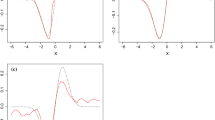Abstract
First, we consider a stationary random field indexed by an increasing sequence of subsets of \(\mathbb {Z}^{d}\). Under certain mixing and anti–clustering conditions combined with a very broad assumption on how the sequence of spatial index sets increases, we obtain an extremal result that relates a normalized version of the distribution of the maximum of the field over the index sets to the tail distribution of the individual variables. Furthermore, we identify the limiting distribution as an extreme value distribution. Secondly, we consider a continuous, infinitely divisible random field indexed by \(\mathbb {R}^{d}\) given as an integral of a kernel function with respect to a Lévy basis with convolution equivalent Lévy measure. When observing the supremum of this field over an increasing sequence of (continuous) index sets, we obtain an extreme value theorem for the distribution of this supremum. The proof relies on discretization and a conditional version of the technique applied in the first part of the paper, as we condition on the high activity and light–tailed part of the field.
Similar content being viewed by others
References
Barndorff-Nielsen, O.E., Schmiegel, J.: Lévy-based tempo-spatial modelling with applications to turbulence. Uspekhi Mat Nauk 159, 63–90 (2004)
Braverman, M., Samorodnitsky, G.: Functionals of infinitely divisible stochastic processes with exponential tails. Stoch. Process. Their Appl. 56(2), 207–231 (1995)
Cline, D.B.H.: Convolution tails, product tails and domains of attraction. Probab. Theor. Relat. Fields 72(4), 529–557 (1986). https://doi.org/10.1007/BF00344720
Cline, D.B.H.: Convolutions of distributions with exponential and subexponential tails. J. Aust. Math. Soc. Ser. A 43(3), 347–365 (1987). https://doi.org/10.1017/S1446788700029633
Embrechts, P., Klüppelberg, C., Mikosch, T.: Modelling Extremal Events for Insurance and Finance Applications of Mathematics. Springer, New York (1997)
Fasen, V.: Extremes of Lévy driven mixed MA processes with convolution equivalent distributions. Extremes 12(3), 265–296 (2008)
Hellmund, G., Prokešová, M., Jensen, E.B.V.: Lé,vy-based Cox point processes. Adv. Appl. Probab. 40, 603–629 (2008)
Jakubowski, A., Soja-Kukieła, N.: Managing local dependencies in asymptotic theory for maxima of stationary random fields. Extremes 22(2), 293–315 (2019)
Jónsdóttir, K.Y., Schmiegel, J., Jensen, E.B.V.: Lévy-based growth models. Bernoulli 14(1), 62–90 (2008)
Jónsdóttir, K.Y., Rønn-Nielsen, A., Mouridsen, K., Jensen, E.B.V.: Lé,vy-based modelling in brain imaging. Scand. Stat. Theory Appl. 40 (3), 511–529 (2013)
Krengel, U.: Ergodic Theorems De Gruyter Studies in Mathematics. Walter de Gruyter, Berlin (1985)
Leadbetter, M.R., Lindgren, G., Rootzén, H.: Extremes and Related Properties of Random Sequences and Processes Springer Series in Statistics. Springer, New York (1983)
Leadbetter, M.R., Rootzén, H.: On Extreme Values in Stationary Random Fields Trends in Mathematics. Birkhäuser, Boston (1998)
Ling, C.: Extremes of stationary random fields on a lattice. Extremes 22, 391–411 (2019)
Pakes, A.G.: Convolution equivalence and infinite divisibility. J. Appl. Probab. 41, 407–424 (2004)
Rajput, B.S., Rosinski, J.: Spectral representations of infinitely divisible processes. Probab. Theor. Relat. Fields 82, 451–487 (1989)
Resnick, S.I.: Extreme Values, Regular Variation and Point Processes Springer Series in Operations Research and Financial Engineering. Springer, New York (2008)
Rønn-Nielsen, A., Jensen, E.B.V: Tail asymptotics for the supremum of an infinitely divisible field with convolution equivalent Lévy measure. J. Appl. Probab. 53(1), 244–261 (2016). https://doi.org/10.1017/jpr.2015.22
Rønn-Nielsen, A., Jensen, E.B.V: Excursion sets of infinitely divisible random fields with convolution equivalent Lévy measure. J. Appl. Probab. 54 (3), 833–851 (2017). https://doi.org/10.1017/jpr.2017.37
Rønn-Nielsen, A., Sporring, J., Jensen, E.B.V.: Estimation of sample spacing in stochastic processes. Image Anal. Stereol. 36(1), 43–49 (2017)
Rønn-Nielsen, A., Jensen, E.B.V.: Central limit theorem for mean and variogram estimators in Lévy-based models. J. Appl. Probab. 56(1), 209–222 (2019)
Sato, K.: Lévy Processes and Infinitely Divisible Distributions Cambridge Studies in Advanced Mathematics. Cambridge University Press, Cambridge (1999)
Schneider, R.: Convex Bodies: The Bruun–Minkowski Theory. Cambridge University Press, Cambridge (1993)
Soja-Kukieła, N.: On maxima of stationary fields. J. Appl. Probab. 56(4), 1217–1230 (2019)
Stehr, M., Rønn-Nielsen, A: Tail asymptotics of an infinitely divisible space-time model with convolution equivalent Lévy measure. J. Appl. Probab. 58 (1), 42–67 (2021). https://doi.org/10.1017/jpr.2020.73
Acknowledgements
We are grateful to Professor Gennady Samorodnitsky, Cornell University, for the very fruitful discussions and suggestions concerning Lévy–driven fields in the early phase of the project.
This work was supported by the Centre for Stochastic Geometry and Advanced Bioimaging, funded by a grant from the Villum Foundation.
Author information
Authors and Affiliations
Corresponding author
Ethics declarations
Conflict of Interests
The authors declare that they have no conflict of interest.
Additional information
Publisher’s note
Springer Nature remains neutral with regard to jurisdictional claims in published maps and institutional affiliations.
This work was supported by the Centre for Stochastic Geometry and Advanced Bioimaging, funded by a grant from the Villum Foundation.
Rights and permissions
About this article
Cite this article
Stehr, M., Rønn-Nielsen, A. Extreme value theory for spatial random fields – with application to a Lévy-driven field. Extremes 24, 753–795 (2021). https://doi.org/10.1007/s10687-021-00415-5
Received:
Revised:
Accepted:
Published:
Issue Date:
DOI: https://doi.org/10.1007/s10687-021-00415-5
Keywords
- Extreme value theory
- Spatial models
- Lévy–based modeling
- Geometric probability
- Intrinsic volumes
- Convolution equivalence
- Random fields




